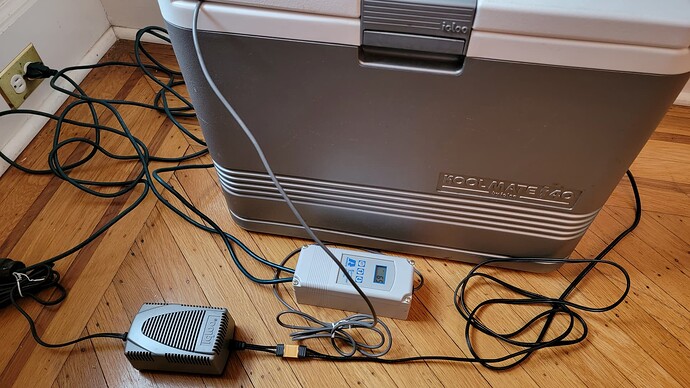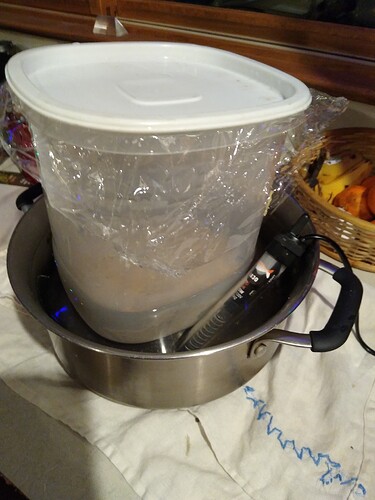Temperature control is very important in brewing i have an old freeze converted to a temperature control fermentation chamber . It is to large to run for a couple loaves. Different strains of beer yeast fermented at different temperature. Low and slow for a clean beer to very warm for Belgian styles and sours. Im figuring to get that sourness in bread warm is better. I’ll probably get around to making a mini control chamber for bread. I have some ideas but wondering what some of you do
My husband is a beer brewer and he made me a temp controlled cooler when I was playing with this Naturally Leavened Christmas Panettone – Breadtopia and Salt Rising Bread.
You can see a bunch of pics of it in the second link.
It’s an electric cooler with a Ranco temp controller (Inkbird is more affordable but wasn’t available back when he got the Ranco).
The cooler had a car plug with a janky adapter for a wall plug, so he rewired the cord to be direct wall plug. There’s also a Peltier chip situation that changes the polarity – whether the box is cooling or heating, and I have to flip the direction of the cord into the cooler for this. Other coolers may have a different setup/just a switch you flip.
I just set it up for a 55-62F Desem starter creation actually so here’s a fresh pic. I’m probably going to move it to my basement though because it’ll barely need to work down there to stay at that low of a temp.
I thought about a cooler but it would take up to much space. I then I was thinking just to use one of the temp controlers I have and use my oven with a light bulb or heat mat. The other thing Im thinking is a water bath with an aquarium heater. Unlike beer we are talking hours not days and weeks.
On another note that Panettone looks alot like an Russian easter bread I made in recycled tin cans. Basically a kugelhopf without the kugelhopf pan
That makes sense. The space of a cooler setup makes most sense for multi-day processes e.g. panettone starter build and the dough are at 80-85F for days or if you consistently want to do long cold ferments e.g. 55F is a nice temp for a slow sour.
I think sourness can come from both hot or cold processes.
Here’s an interesting thread discussing variables and acids.
The ‘sour’ in sourdough comes mostly from the dough being cooler. Less sour when the dough is warmer.
I use an Inkbird temp controller with ‘cool’ and ‘heat’ sockets, plug a the mini fridge into the the ‘cool’ side and a light bulb into the ‘heat’ side, toss the light bulb into the mini fridge. the setup is very much like what Melissa has. I chose a light bulb because the element in the bulb is low mass so when it reaches temp and the controller turns it off it does not continue to radiate heat and allow the temp to drift upward. Overall, I can warm or cool proof dough anytime of the year, regardless of room temp. People are always trying to get rid of the mini fridges. I got my free.
Down side: loss of 20in x 20in floor space.
Up side: gain 20in x 20in mini-counter space.
Well the mini fridge is nice but im already running multiple fridges so trying to cut back. I need to read @Fermentada s link but maybe I need to rethink. Maybe do my levain low and slow then the first fermentation warm and the proof ? Need to do some research
Read the link still not entirely clear but apparently both temperatures are needed. Ive gotten the taste/smell Ive wanted before but not consistently. So that is why I’m going to monitor my temps throughout this bake today. I started a levain this morning mixed at about 1:2:2 @ 85° going to let it sit on the counter ambient 64° for about 12 hrs at which time ill mix my dough to 80° and hold it there over night. I have all day to think about that 80° maybe a bit lower since I’ll be sleeping. Tomorrow I’ll proof at 90° to bake
Umm, no.
Take a look at this 6-min video, especially the last minute or so, the part with the chart:
(Melissa, this is a reference to liquid vs stiff starter/dough and the diff in sourness.)
Also, a long read with excellent info using controlled temp proofing, 2-part article with a reference to a Country Bread recipe (that is excellent!) using controlled temp proofing to reduced sourness:
Ok now im even more confused. I read above haven’t watched the vid yet. But I thought you said in your first post cooler for sour the article seems to say the opposite. I keep my culture in the fridge and never feed it I pull some out to make my levain usually use wheat for it. I take what I need and return to the culture jar. Eventually the culture gets more sour. Does this make sense? I started baking again after a layoff so am building a new culture and was trying to replicate it but not sure how. Probably should keep notes
You are right! I went and re-read the article, it and the video contradict each other.
The guy in the video is Karl De Smedt. I jokingly say he invented sourdough bread. In reality, he probably knows more about it than anyone else that is out in public and on social media promoting the science of sourdough.
There is another video I was trying to locate, but couldn’t find, that has Karl explain the two primary kinds of bacteria in detail and how hydration and temp effect each kind of bacteria. In the other video he uses the same chart but explains it as he creates the chart.
You can try your own experiment, make two basic loaves, ferment one low and slow, the other high and fast. If you do, please let us know how it worked out for you.
And YES!!! Unfed sourdough starter is slowly going more and more sour. Without re-watching it, I think that was in the same video posted above, also. At some point unfed sourdough starter becomes possibly not safe to consume.
Really probably safe after you hit it with 500° temperature
Besides its fed when I return leftover levain to it
One has to look at the complete process, not one single aspect. Sourdough and the resulting taste will be affected at every stage from starter to bake.
Cooler temps for more acetic ferment. However, I believe if you keep your starter too much in the fridge it loses strength and the resulting bread is less flavourful.
I used to neglect my starter for weeks at a time and no matter what I did the resulting loaves were too plain. I’ve since adopted a more regular feeding schedule and now it produces lovely tasting loaves. So while less feeds produce more acids, neglect has a negative effect. Everything has a balance. You can make a well fed sourdough starter more acidic by fermenting for longer. And taste is not all about the pH level and has a lot to do about TTA. One can have a relatively weak acid but has more flavour than a stronger acid if the TTA is higher.
One can go down the rabbit hole looking into all of this. I prefer the approach of trying something out and if you like the results learn and build from that, incorporating it into your baking.
Okay I did a bread at the low and slow and the bread came out fine but still couldn’t replicate the elusive smell. So I was able to get a aquarium heater and will ferment warm using this teqnique
by the way im using Melissa’s rye bread recipe which is similar to my standard ratio
Low 80° but this heater will go 90°+ so next ill do it hot. I’m thinking it may just be the age of my yeast starter. Its still pretty young maybe needs to get aged


